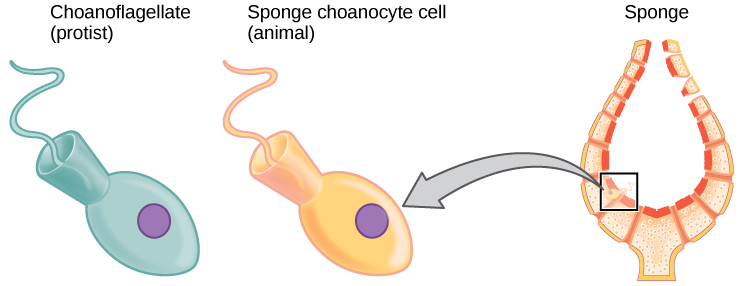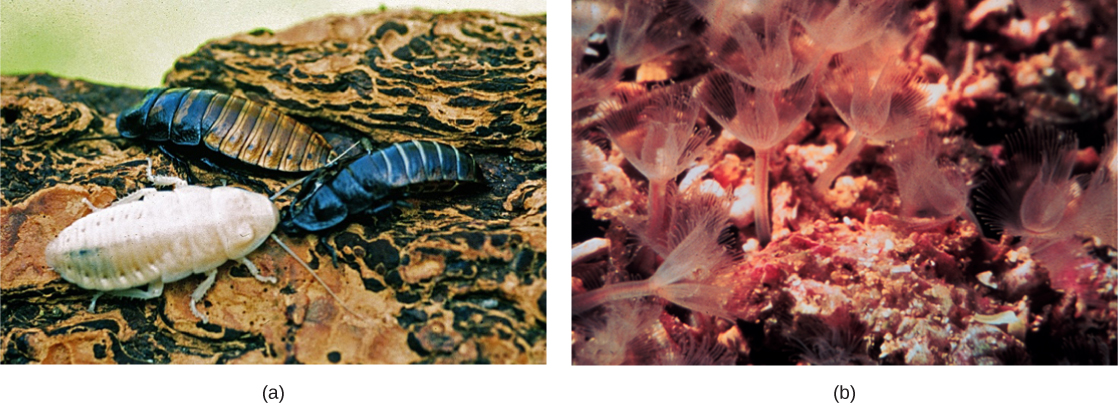Which Method Reveals That Fungi Are More Closely Related To Animals Than To Green Plants
Introduction to Animate being Diversity
139 Creature Phylogeny
Learning Objectives
By the end of this section, y'all will be able to do the following:
- Interpret the metazoan phylogenetic tree
- Describe the types of data that scientists use to construct and revise animal phylogeny
- Listing some of the relationships within the mod phylogenetic tree that have been discovered every bit a result of modern molecular data
Biologists strive to understand the evolutionary history and relationships of members of the animal kingdom, and all of life, for that thing. The written report of phylogeny (the branching sequence of evolution) aims to determine the evolutionary relationships between phyla. Currently, most biologists divide the animal kingdom into 35 to 40 phyla. Scientists develop phylogenetic trees, which serve as hypotheses about which species take evolved from which ancestors.
Retrieve that until recently, only morphological characteristics and the fossil record were used to determine phylogenetic relationships amidst animals. Scientific agreement of the distinctions and hierarchies betwixt anatomical characteristics provided much of this knowledge. Used solitary, however, this information tin exist misleading. Morphological characteristics (such as skin color, trunk shape, etc.) may evolve multiple times, and independently, through evolutionary history. Coordinating characteristics may appear similar betwixt animals, but their underlying evolution may be very unlike. With the advocacy of molecular technologies, modern phylogenetics is now informed by genetic and molecular analyses, in addition to traditional morphological and fossil data. With a growing agreement of genetics, the animal evolutionary tree has changed substantially and continues to change as new DNA and RNA analyses are performed on boosted animal species.
Constructing an Beast Phylogenetic Tree
The electric current agreement of evolutionary relationships amongst animal, or Metazoa, phyla begins with the stardom betwixt animals with true differentiated tissues, chosen Eumetazoa, and animal phyla that do non have true differentiated tissues, such as the sponges (Porifera) and the Placozoa. Similarities between the feeding cells of sponges (choanocytes) and choanoflagellate protists ((Effigy)) have been used to suggest that Metazoa evolved from a common ancestral organism that resembled the moderncolonial choanoflagellates.
Choanoflagellates and choanocytes. Cells of the protist choanoflagellate clade closely resemble sponge choanocyte cells. Chirapsia of choanocyte flagella draws water through the sponge so that nutrients tin can exist extracted and waste material removed.

Eumetazoa are subdivided into radially symmetrical animals and bilaterally symmetrical animals, and are thus classified into the clades Bilateria and Radiata, respectively. Every bit mentioned earlier, the cnidarians and ctenophores are brute phyla with true radial, biradial, or rotational symmetry. All other Eumetazoa are members of the Bilateria clade. The bilaterally symmetrical animals are farther divided into deuterostomes (including chordates and echinoderms) and two distinct clades of protostomes (including ecdysozoans and lophotrochozoans) ((Figure)a,b). Ecdysozoa includes nematodes and arthropods; they are then named for a usually establish characteristic among the group: the physiological process of exoskeletal molting followed by the "stripping" of the outer cuticular layer, called ecdysis. Lophotrochozoa is named for ii structural features, each common to certain phyla within the clade. Some lophotrochozoan phyla are characterized by a larval stage called trochophore larvae, and other phyla are characterized past the presence of a feeding structure called a lophophore (thus, the shorter term, "lopho-trocho-zoa").
Ecdysozoa. Animals that molt their exoskeletons, such as these (a) Republic of madagascar hissing cockroaches, are in the clade Ecdysozoa. (b) Phoronids are in the clade Lophotrochozoa. The tentacles are part of a feeding structure called a lophophore. (credit a: modification of work past Whitney Cranshaw, Colorado State University, Bugwood.org; credit b: modification of work by NOAA)

Link to Learning
Explore an interactive tree of life here. Zoom and click to learn more than nearly the organisms and their evolutionary relationships.
Modernistic Advances in Phylogenetic Understanding Come from Molecular Analyses
The phylogenetic groupings are continually being debated and refined by evolutionary biologists. Each twelvemonth, new evidence emerges that further alters the relationships described by a phylogenetic tree diagram.
Link to Learning
Watch the following video to larn how biologists apply genetic data to decide relationships among organisms.
Nucleic acid and protein analyses have greatly modified and refined the mod phylogenetic animal tree. These data come up from a multifariousness of molecular sources, such as mitochondrial Dna, nuclear Deoxyribonucleic acid, ribosomal RNA (rRNA), and certain cellular proteins. Many evolutionary relationships in the mod tree accept only recently been determined from the molecular evidence. For example, a previously classified group of animals called lophophorates, which included brachiopods and bryozoans, were long-thought to be primitive deuterostomes. Extensive molecular analysis using rRNA information plant these animals are actually protostomes, more closely related to annelids and mollusks. This discovery allowed for the distinction of the protostome clade Lophotrochozoa. Molecular information have too shed light on some differences within the lophotrochozoan group, and the placement of the Platyhelminthes is particularly problematic. Some scientists believe that the phyla Platyhelminthes and Rotifera should really belong to their own clade of protostomes termed Platyzoa.
Molecular inquiry similar to the discoveries that brought nearly the stardom of the lophotrochozoan clade has also revealed a dramatic rearrangement of the relationships between mollusks, annelids, arthropods, and nematodes, and as a consequence, a new ecdysozoan clade was formed. Due to morphological similarities in their segmented body types, annelids and arthropods were one time thought to be closely related. However, molecular evidence has revealed that arthropods are actually more than closely related to nematodes, now comprising the ecdysozoan clade, and annelids are more closely related to mollusks, brachiopods, and other phyla in the lophotrochozoan clade. These two clades now make upwardly the protostomes.
Another change to one-time phylogenetic groupings because of mod molecular analyses includes the emergence of an entirely new phylum of worm called Acoelomorpha. These acoel flatworms were long thought to belong to the phylum Platyhelminthes because of their similar "flatworm" morphology. However, molecular analyses revealed this to exist a false human relationship and originally suggested that acoels represented living species of some of the earliest divergent bilaterians. More recent research into the acoelomorphs has called this hypothesis into question and suggested that the acoels are more closely related to deuterostomes. The placement of this new phylum remains disputed, just scientists hold that with sufficient molecular data, their true phylogeny will be determined.
Another instance of phylogenetic reorganization involves the identification of the Ctenophora as the basal clade of the animate being kingdom. Ctenophora, or comb jellies, were once considered to be a sister grouping of the Cnidaria, and the sponges (Porifera) were placed as the basal animal group, sister to other animals. The presence of nerve and muscle cells in both the Ctenophores and the Cnidaria and their absence in the Porifera strengthened this view of the relationships among uncomplicated animal forms. However, recent molecular analysis has shown that many of the genes that support neural development in other animals are absent from the Ctenophore genome. The musculus cells are restricted to the mouth and tentacles and are derived from cells in the mesoglea. The mitochondrial genome of the Ctenophores is small and lacks many genes constitute in other creature mitochondrial genomes. These features plus the absenteeism of Hox genes from the Ctenophores have been used to argue that the Ctenophores should exist considered basal or as a sister grouping of the Porifera, and that the evolution of specialized nerve and muscle tissue may have occurred more than one time in the history of animal life. Although Ctenophores accept been shown as basal to other animals in the phylogeny presented in Affiliate 27.2, debate on this consequence is probable to continue as Ctenophores are more than closely studied.
Changes to the phylogenetic tree tin can be hard to runway and understand, and are testify of the process of science. Data and analytical methods play a significant role in the development of phylogenies. For this reason – because molecular analysis and reanalysis are not consummate — nosotros cannot necessarily dismiss a former phylogenetic tree every bit inaccurate. A recent reanalysis of molecular evidence by an international grouping of evolutionary biologists refuted the proposition that comb jellies are the phylogenetically oldest extant metazoan group. The written report, which relied on more sophisticated methods of analyzing the original genetic data, reaffirms the traditional view that the sponges were indeed the showtime phylum to diverge from the common ancestor of metazoans. The ongoing discussion concerning the location of sponges and comb jellies on the animal "family unit tree" is an example of what drives scientific discipline forward.
Department Summary
Scientists are interested in the evolutionary history of animals and the evolutionary relationships amidst them. There are 3 main sources of information that scientists use to create phylogenetic evolutionary tree diagrams that illustrate such relationships: morphological data (which includes developmental morphologies), fossil record data, and, most recently, molecular data. The details of the modern phylogenetic tree modify frequently as new data are gathered, and molecular data has recently contributed to many substantial modifications of the understanding of relationships between animal phyla.
Review Questions
Consulting the mod phylogenetic tree of animals, which of the post-obit would not constitute a clade?
- deuterostomes
- lophotrochozoans
- Parazoa
- Bilateria
C
Which of the post-obit is thought to exist the most closely related to the common animal antecedent?
- fungal cells
- protist cells
- plant cells
- bacterial cells
B
Every bit with the emergence of the Acoelomorpha phylum, it is common for ____ data to misplace animals in shut relation to other species, whereas ____ data ofttimes reveals a different and more accurate evolutionary relationship.
- molecular : morphological
- molecular : fossil record
- fossil record : morphological
- morphological : molecular
D
Critical Thinking Questions
Describe at least two major changes to the brute phylogenetic tree that have come about due to molecular or genetic findings.
2 new clades that comprise the two major groups of protostomes are chosen the lophotrochozoans and the ecdysozoans. The formation of these two clades came about through molecular enquiry from Dna and protein data. Also, the novel phylum of worm chosen Acoelomorpha was determined due to molecular data that distinguished them from other flatworms.
How is it that morphological data alone might lead scientists to group animals into erroneous evolutionary relationships?
In many cases, morphological similarities between animals may be merely superficial similarities and may not indicate a true evolutionary relationship. One of the reasons for this is that certain morphological traits can evolve forth very dissimilar evolutionary branches of animals for similar ecological reasons.
Glossary
- Ecdysozoa
- clade of protostomes that showroom exoskeletal molting (ecdysis)
- Eumetazoa
- grouping of animals with truthful differentiated tissues
- Lophotrochozoa
- clade of protostomes that showroom a trochophore larvae stage or a lophophore feeding structure
- Metazoa
- group containing all animals
- Parazoa
- grouping of animals without truthful differentiated tissues
Source: https://opentextbc.ca/biology2eopenstax/chapter/animal-phylogeny/
Posted by: waitbrobbegreare1964.blogspot.com

0 Response to "Which Method Reveals That Fungi Are More Closely Related To Animals Than To Green Plants"
Post a Comment